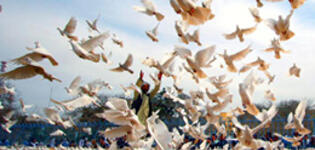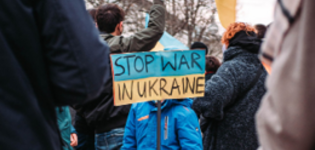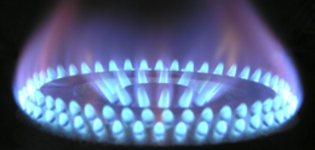Blog
What would be the economic consequences of a military stalemate in Ukraine?
Russia’s war in Ukraine may reach a stalemate as neither side appears in reach of a military victory. Unless a settlement can be agreed, a frozen conflict may emerge, which will delay economic recovery in Ukraine. This will also extend the cost of living crisis around the world.
In February 2022, Russia launched a full-scale military invasion of Ukraine. By September, Russia controlled large tracts of Ukrainian territory and strategic urban centres in eastern Ukraine. But it had ultimately failed to achieve its main military objective of toppling the Ukrainian government in Kyiv.
Despite significant Ukrainian gains in September, neither side currently appears powerful enough to win the conflict outright. As a line of contact stabilises and parts of eastern Ukraine remain under Russian occupation, is a military stalemate likely? And what might be the economic consequences of the absence of a negotiated agreement?
How has the conflict progressed and is a military stalemate likely?
Russia launched its so-called ‘special military operation’ in Ukraine in February 2022. But Russia’s military involvement in Ukraine dates back to 2014 when it supported separatists in the eastern regions of Donbas and Luhansk, and the southern peninsula of Crimea. Russia annexed the latter after an illegal referendum in the same year.
The conflict in eastern Ukraine was fought between separatists backed by Russia and Ukrainian forces that were, at first, an amalgam of informal militias and the Ukrainian army. Over time, this became an increasingly centralised and effective military force. The conflict simmered at low intensity, with a relatively stable line of contact stretching from north of the city of Luhansk to east of the city of Mariupol. Despite sporadic episodes of heavy fighting, movement of people and goods across the contact line resumed, although this was heavily controlled through a small number of border crossings.
Russia’s role in the conflict was initially debatable, but the origin of the ‘little green men’ became well known, and in 2015, Russian president Vladimir Putin admitted to their presence. Military support often guised as humanitarian aid and the direct involvement of military personnel ensured high levels of control over the separatist armed groups and region by Russia.
Russia began amassing troops near the Ukrainian borders with Russia and Belarus around March 2021. Claiming to want to protect ethnic Russians from genocide, Vladimir Putin launched a full-scale invasion of Ukraine on 24 February 2022. This included bombing across the entire Ukrainian territory and an attempt to take the capital city, Kyiv. Despite predictions of imminent defeat for the Ukrainian army, the Russian army ultimately failed to achieve their primary military objectives. This was due to a combination of staunch Ukrainian resistance and poor logistics.
In late March, the Russian defence ministry refocused its military power on eastern Ukraine, aiming to create a land bridge between Crimea and the separatist regions. Russia employed brutal and often indiscriminate military tactics to take the strategic cities of Kherson in March, Mariupol in mid-May and Severodonetsk in late May. Russia didn’t succeed in achieving its initial goals, and while significant tracts of land in eastern and southern Ukraine came under occupation by Russian forces, Ukrainian forces are increasingly pushing the Russian army back.
Indeed, in recent weeks, Ukrainian forces have forced Russian troops to retreat, especially in the north-eastern region of Kharkiv, where the Ukrainian government claims to have liberated over 3,000 square kilometres. In response to this military setback, Putin ordered the mobilisation of army reservists to support the ailing campaign. But despite a successful Ukrainian counter-offensive, there are early signs of a military stalemate. Neither side appears strong enough to win the conflict outright.
What are the prospects for a negotiated settlement?
The international community will play an important role in how Russia’s war in Ukraine ends. The invasion was largely condemned, although there were some notable absences, such as China, North Korea, Iran and Syria.
Western states have responded in two ways. First, the West imposed debilitating sanctions that targeted the Russian economy. Sanctions are inflicting large costs on people in Russia, but their effectiveness in making the Russian elite abandon their foreign policy goals in Ukraine is not clear. Generally, economic sanctions can inflict costs on target states, but many question whether they are the most effective foreign policy tool for forcing states to change their course of action. Writing over two decades ago, Robert Pape argued that: ‘Pervasive nationalism often makes states and societies willing to endure considerable punishment rather than abandon what are seen as the interests of the nation.’ Iran has since become testament to this claim.
While it is difficult to assess public opinion in Russia, early polls suggested that its citizens supported the invasion, and polls show high approval rates for Russian leadership. As winter approaches, Russia is flexing its own economic muscles by halting important energy supplies to Europe. While unprecedented in scale and scope, it is not obvious whether economic sanctions will stop Russia’s aggression in Ukraine or force the country to the negotiating table. Second, the West has supplied military equipment to support Ukraine in its fight against Russia. In an unprecedented move, the European Union sent military assistance to support the Ukrainian armed forces. At the same time, the UK and the United States have provided effective weaponry aimed at providing Ukraine with the tools to overcome Russia’s important military advantages.
While surveys indicate that the Western public overwhelmingly supports their states’ response to the Russian invasion, a small but growing group are raising concerns over warmongering. For example, in the UK, the former leader of the opposition Labour Party, Jeremy Corbyn, urged Western countries to stop arming Ukraine because it will ‘prolong and exaggerate’ the war.
There is a large body of relevant research on the role of external states in civil wars and, specifically, the mixed track record of interventions in ending hostilities. Interventions affect the capabilities of opposing sides in a conflict and, ultimately, conflict duration. Existing theories tend to focus on a balance of power between government and rebel forces, which is often measured in troop numbers, military capabilities and resources. External support may shorten wars if it is provided to one side, but not both. Certain forms of support – mainly money and weapons – cause greater uncertainty over fighting capability, which causes sides to continue fighting rather than settle the dispute. Although there is variation in the role of external states and conflict duration, a consensus has emerged that conflicts tend to be harder to resolve when external states intervene, especially if the two sides achieve some form of military parity. With increasingly effective military support reaching Ukrainian troops on the frontline, it is unlikely that the conflict will end soon.
There is a larger trend for conflicts not to end in victory or an agreement. Researchers have argued that a norm emerged in the 1990s that led the United States to accept high costs to achieve negotiated settlements despite having the ability to help proxies achieve outright military victories. Due to a logic of appropriateness, Western policy-makers came to think that wars should end a certain way, namely through compromise based on democratic principles. These experts also note that an emerging goal of stabilisation marked conflicts in Iraq and Afghanistan. Indeed, conflict termination data from the Uppsala Conflict Data Program (UCDP) show that conflicts are increasingly likely to end in low-intensity activity – that is, conflict continues but does not amount to more than 25 battle-related deaths per year. Combined, most research points to a military stalemate and, ultimately, a low-intensity or frozen conflict.
What might a frozen conflict look like?
It is difficult to predict how Russia’s war in Ukraine will develop. A settlement that sees Russia retreating to the pre-conflict line of contact is hard to imagine. Neither Russia nor Ukraine is prepared to agree to a negotiated settlement that ultimately amounts to failure to achieve their aims. And yet a United Nations-backed deal negotiated by Turkey to allow the export of grain from Ukraine provides ‘a beacon of hope’ that Russia and Ukraine may cooperate, at least in economic matters that benefit both sides.
Taking both the unlikelihood of a negotiated settlement to the war and emerging cooperation in trade, a possible future scenario is a protracted conflict with a volatile line of contact. In time, occupied lands in eastern Ukraine may be annexed by Russia through unrecognised referenda or a de facto state may emerge from an increasingly cold conflict. De facto states are not recognised by most states and thus do not have access to the legal rights afforded to states. As there is no international legal protection for their existence, they are often at risk of being forcibly re-integrated into their ‘parent’ state – in this case, Ukraine – and rely heavily on their external patron for protection – in this case, Russia.
There is a rich body of research on de facto states with a regional focus on the post-Soviet space. Places like Transnistria, Nagorno-Karabakh, Abkhazia and South Ossetia were part of the Soviet Union. But de facto states also exist elsewhere in the world, for example Taiwan, Somaliland and Rojava. Researchers focus on how these state-like entities emerge and how long they last until they are either re-incorporated into their parent state – as was the case when Russia invaded Chechnya in 1999 – or they are recognised by the international community – as was the case with South Sudan in 2011. Scholars therefore often focus on the dynamics of recognition and non-recognition, or on processes aimed at settling the conflict between the de facto state and its parent.
What will be the economic consequences of a frozen conflict?
The economic consequences of the war are dwarfed by the current human suffering and loss of life. Yet the economic impacts of war on Ukraine and beyond are immense. In the short term, Ukrainian economic output is currently a fraction of its pre-war levels.
Ukraine and Russia are the biggest producers in agriculture and food globally. Described collectively as the breadbasket of the world, restricted economic activity within Ukraine and its limited ability to export raw goods, particularly food, have led to soaring food costs. This is directly linked to inflation in Europe, but crucially, record goods prices have triggered a global crisis that is driving millions into poverty and hunger, especially in low- and lower-middle income countries. Despite recent shipments of grain, the Russian blockade of Ukrainian ports and sanctions against Russia mean that food prices are likely to increase further.
The long-term economic costs of the war are equally alarming. People directly affected by violence are maimed, killed and displaced. Children miss out on crucial years of education and training. Combined with the loss of property and infrastructure – such as roads, bridges and equipment – all of this will significantly reduce future economic activity of people and areas most affected by the war. The destruction of human and physical capital has reduced Ukraine’s macroeconomic performance, and a frozen conflict will prolong the economic costs of this war. While post-conflict states often experience a rapid economic rebound, a frozen conflict is unlikely to follow such a path.
As the conflict cools and a de facto state emerges in contested parts of Ukraine, a semblance of order will return for civilians in their everyday lives. But economic activity in de facto states is often restricted because they are not internationally recognised. There may be informal trade into the de facto state over the line of contact. This dynamic was clear in Northern Ireland during the conflict known as the ‘Troubles’ and the civil war in Colombia – two wars heavily marked by cross-border smuggling and narco-trade. But exports from government and Russia controlled areas are unlikely to resume to pre-war levels. In the absence of concessions by Russia to allow Ukrainian exports, sanctions that limit Russian agricultural exports will remain while Ukraine’s most industrial lands are ravaged by war. Exports from occupied lands in the east and south will be limited to Russia and its allies, both of which will not be able to trade on international markets due to economic sanctions. Ultimately, a frozen conflict will ensure that the global economic crisis persists.
It is thus no surprise that Ukraine launched a counter-offensive in late August and September. It aims to signal the ability to regain Russian occupied lands to external supporters whose resolve will weaken if Ukraine cannot show that they can prevent a frozen war with such high economic costs.
Patricia Justino is a Deputy Director at UNU-WIDER. She is a development economist who works at the interface between Development Economics and Political Science. She is a leading expert on political violence and development, and the co-founder and co-director of the Households in Conflict Network. She is currently Deputy Director at UNU-WIDER and Professorial Fellow at the Institute of Development Studies (IDS) in Brighton, UK (on leave).
Kit Rickard is a Research Associate at UNU-WIDER. He completed his PhD in International Relations at the Political Science Department, University College London (UCL), supervised by Prof. Kristin M. Bakke and Dr. Nils W. Metternich. His doctoral study focused on how states affect foreign civil wars, with a specific focus on how diverging forms of external support shape relations among and within rebel groups. The central questions were: Why do states provide different forms of support? What role do external states play in shaping the relations between rebels in multi-actor civil wars?
This article was originally published in the Economics Observatory. Read the original article here.
The views expressed in this piece are those of the author(s), and do not necessarily reflect the views of the Institute or the United Nations University, nor the programme/project donors.
 Join the network
Join the network

















